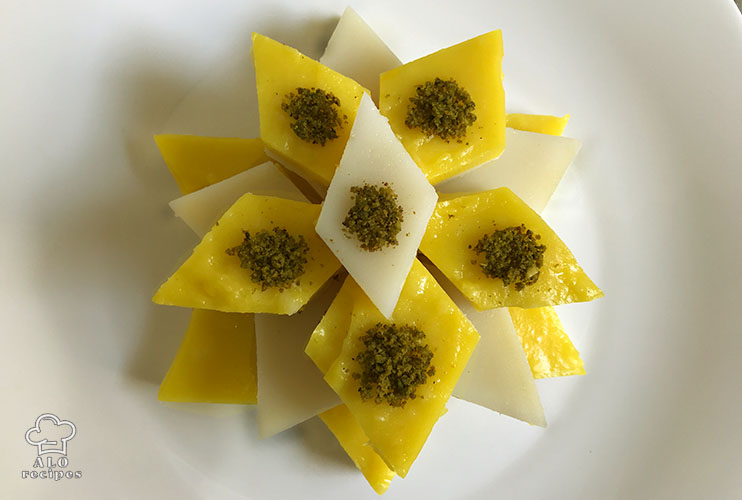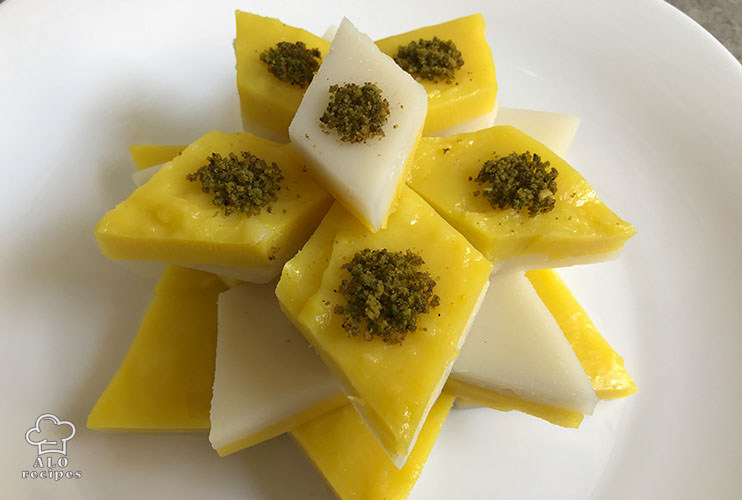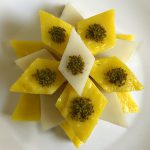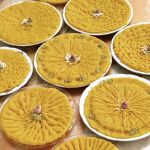Tar Halva
Tar Halva is very unique in texture. It’s so soft and tender, hence the name Tar Halva. Tar means moist in Persian, but it also means fresh and refreshing. So the name Tar Halva is pretty self-explanatory!
In Iran, there are various recipes for Tar Halva. Tar Halva originating from shiraz is one of the most famous of them. Yazd, Tabriz, and Hamadan Tar Halva are also popular.
Tar Halva is a delicious and lovely sweet, very classy for gatherings. It can be served as dessert or next to some tea for an evening snack.
In this post, we’ll teach you 2 Tar Halva recipes, one from shiraz and one from Tabriz. You can choose whichever you like and make it at home!
What’s the difference between Tar Halva Shirazi and Tar Halva Tabriz?
Tar Halva Shirazi has a light and soft texture, like a thick porridge or Arabic Muhallebi. It’s different from other Iranian Halva that contain toasted flour. It’s prepared in two colors (white and yellow) and is best served cold.
Tar Halva Tabriz has a different recipe. Like the common Halva served in Iranian funerals, the flour is toasted, and nectar is poured into it. It’s served warm or cold. Just like baklava cake, it contains cardamom powder and rose water that give it a heavenly taste.

Tar Halva Shirazi Recipe + All tips
Tar Halva Shirazi contains wheat starch, rice flour, milk, water, and rose water. It’s stirred constantly over heat until the liquid thickens. It’s like making porridge but thicker.
Step 1- Preparation
Select a rimmed square or rectangle plate. Add a few drops of oil to the plate and spread them. You don’t need to grease the surface too much.
I used a 10*6 inch plate (25*15 cm). If you prefer having thicker cuts, choose a 9*5 inch plate.
Step 2- Dissolve the rice flour in milk and the starch in water
Dissolve the starch in cold water. Stir until it’s completely solved. Mix milk and rice flour in a pot and stir until no lump remains. Then, add the starch mixture to them.
Sieve the ingredients to make sure it’s all smooth and without any solid parts.

Step 3- Put the ingredients on low heat
Pour the mixture into a pot and put it on low heat. You should stir this Halva constantly. If the heat increases or you ignore it for a moment, the Halva might burn or lump. Stir from deep within the mixture since both starch and rice flour quickly sink to the bottom of the top. If you see small lumps, press on them with the back of a spoon and break them up.
After 10-15 minutes of stirring, you slowly start to notice the raw smell of the flour changing into a pleasant aroma as the liquid thickens. It takes at least 40 to 60 minutes for the Tar Halva to become thick enough. It might need more time, depending on the heat level.
Making Tar Halva Shirazi requires patience. If you turn the heat up in hopes of getting things done faster, the raw taste and aroma of the rice flour and wheat starch remains, and the result won’t taste as good.

Step 4- Add sugar and rose water
Once the mixture thickens, just like porridge, add the sugar and rose water. Stir constantly. Eventually, it becomes more rigid and heavier. It becomes hard to stir and starts to bubble; this is a good sign.
In the end, the liquid becomes thick enough and you can see spoon traces on it. This means your Tar Halva Shirazi is ready. Turn the heat off.

Step 5- Pour the Tar Halva inside the rimmed plate
Pour half of the mixture into the greased plate. Add steamed saffron to the other half and immediately pour it on the white layer. Do not worry about the two blending since they’re thick and firm.
Let the Tar Halva reach room temperature, and close the lid of the container. Leave it in the fridge for 4 hours. Once it’s cold, take it out. Use a knife to separate the Tar Halva from the walls of the plate. Cut it into squares or diamonds and place them on your serving platter. Decorate them with pistachio powder, coconut powder, or Damask roses, and serve!

Tips:
- If the liquid starts to lump while on the stove, use the back of a spoon to break them up.
- You can make a uni-colored Tar Halva. Make all of it white or all of it yellow with saffron.
- When cutting, clean the knife after every cut to have cleaner cuts.
- Tar Halva Shirazi should be stored in the fridge. It contains milk that can spoil quickly, so try to finish it all up in one or two days!
- For those with stomach problems, eating this Halva is not recommended since it has wheat starch, and it can be pretty heavy on the stomach.
Tar Halva Shiraz
Ingredients
- ½ cup Flower starch 75 grams
- 2 cup Water
- 3 cup Milk
- ¼ cup Rice flour
- 1 cup Sugar
- ½ cup Rosewater
- 2 tbsp Thick brewed saffron for color
Instructions
- Select a rimmed square or rectangle plate. Add a few drops of oil to the plate and spread them.
- Dissolve the starch in cold water. Mix milk and rice flour in a pot and stir until no lump remains. Then, add the starch mixture to them.
- Pour the mixture into a pot and put it on low heat. You should stir this Halva constantly. It takes at least 40 to 60 minutes for the Tar Halva to become thick enough. If you turn the heat up in hopes of getting things done faster, the raw taste and aroma of the rice flour and wheat starch remains, and the result won’t taste as good.
- Once the mixture thickens, just like porridge, add the sugar and rose water. Stir constantly. Eventually, it becomes more rigid and heavier.
- Pour half of the mixture into the greased plate. Add steamed saffron to the other half and immediately pour it on the white layer.
- Leave it in the fridge for 4 hours. Use a knife to separate the Tar Halva from the walls of the plate. Cut it into squares or diamonds.Decorate them with pistachio powder, coconut powder, or Damask roses, and serve!
Can I increase the heat to quicken the cooking process?
In other Halva recipes, like Halva Zanjabil, the flour is toasted. However, in Tar Halva the whole mixture receives heat, in which the flour and starch are cooked.
So, if you increase the heat in hopes of getting your Halva ready faster, the liquid thickens but will still taste and smell raw. It will not acquire the original Tar Halva Shirazi taste.

What if the Tar Halva aggregates?
Small lumps can be broken up easily using the back of a spoon. However, if you’re not careful enough and the whole thing aggregates, you need to push the lumps through a sieve with the back of a spoon and heat them again.
Why does Tar Halva Shirazi crack while being cut?
If your Tar Halva cracks when you try to cut it, it can have two reasons:
- You didn’t close the lid properly before putting it in the fridge.
- The ingredients weren’t cooked enough, the water still had not fully evaporated, and the liquid was not thick enough.
Tar Halva Tabriz Recipe
In traditional Tar Halva Tabriz, the flour is toasted for a short while, and nectar is poured on it. The nectar contains egg yolks, and the texture is very soft.

Step 1- Toast the flour
In a pan, toast the wheat flour and rice flour. The toasting is different from the one used in the traditional funeral Halva recipe. The flour should not change color, it just needs to lose its raw aroma. If you see lumps, sift them.
Step 2- Add oil to the flour
Add liquid oil to the flour mixture and sauté a little. Once the flour absorbs all the oil, add cardamom powder.
Step 3- prepare the nectar
Heat water and sugar in a pot on the stove. The nectar doesn’t need to thicken. Once it starts boiling, add saffron and rose water.
Take two spoons of the nectar and mix them with the egg yolks to bring the yolks’ temperature up. If you drop the yolks into the pot all at once, they quickly cook and ruin the nectar’s texture.
Turn the heat off and add the yolks to the rest of the nectar. The yolks will eventually cook at this temperature, so don’t worry about them staying raw.
Step 4- Mix the nectar and flour
Pour the nectar on the toasted flour and stir. Once the nectar evaporates, turn the heat off.
Pour Tar Halva Tabriz into a plate and decorate it with pistachio powder or Damask roses.

Tips:
- Tar Halva Tabriz has a beautiful bright and golden color.
- Toast wheat flour and rice to remove their raw smell. If you see bullets if flour, sift them.
- You cannot use solid oil in this recipe. Unlike Halva Zanjabil, egg yolk, and solid oil prevent Halva from having the desired soft texture and will harden it.
Tar Halva Tabriz
Ingredients
- 110 grams Oil
- 175 grams Wheat flour roasted
- 110 grams Rice flour roasted
- 1 tsp Cardamom powder
- ⅛ tsp Salt
Tar halva nectar (syrup)
- 1 cup Water 160 ml
- 250 grams Sugar
- 1 Egg yolk
- ¼ cup Rose water
Instructions
- In a pan, toast the wheat flour and rice flour. The flour should not change color, it just needs to lose its raw aroma.
- Add liquid oil to the flour mixture.
- Heat water and sugar in a pot on the stove. Once it starts boiling, add saffron and rose water. Take two spoons of the nectar and mix them with the egg yolks. Add the yolks to the rest of the nectar
- Pour the nectar on the toasted flour and stir. Once the nectar evaporates, turn the heat off. Tabriz Tar Halwa is ready.
Conclusion
In this post, I introduced two of the most popular Iranian Tar Halva recipes. One of them originates from beautiful Tabriz in the north of Iran, and the other is from the city of love, Shiraz. Each has its unique taste and texture.
Tar Halva Shirazi is served cold. Its preparation needs patience and so much stirring until the rawness of rice flour and starch is gone. It’s different from Halva Zanjabil which contains wheat flour.
Tar Halva Tabriz is wholly distinct from the Shirazi version. The flour is toasted and nectar is added to it. It has a divine aroma of cardamom and rose water. It’s very soft in texture.
I believe both of them are incredibly delicious and lovely. Let me know which recipe you’ve tried and which one you would like to try.



